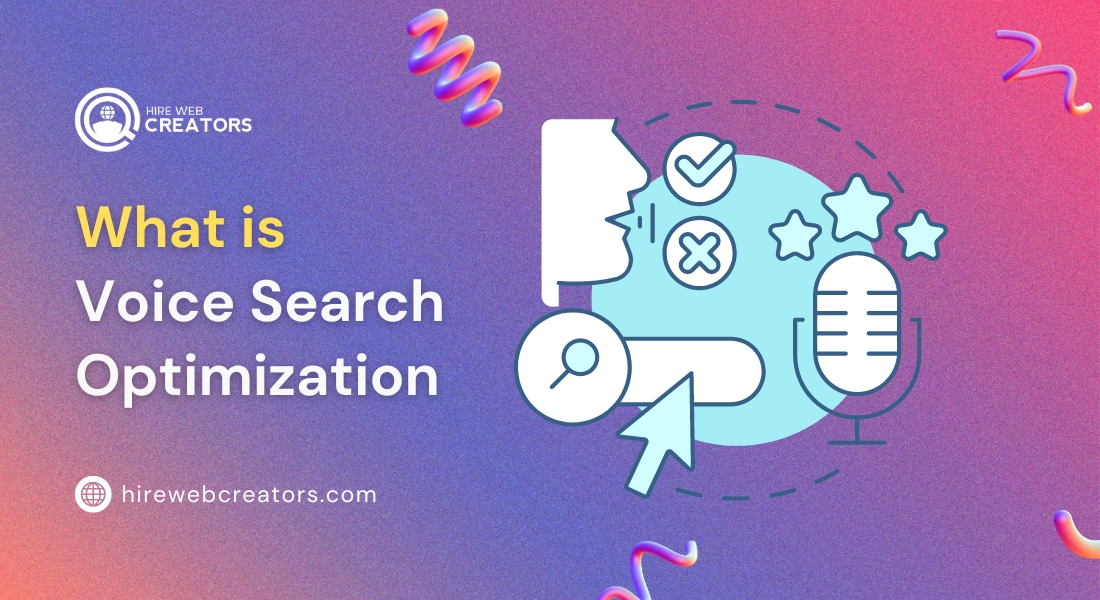

Voice Search Optimization: 10 Powerful Strategies to Dominate
Elevate your B2B website with expert voice search optimization strategies. Learn how to enhance visibility and captivate your audience in the voice-first era!
One of the most important strategies that B2B businesses need to implement to be ahead of their competition is through voice search optimization, especially amidst the rapidly changing digital scenario today. With the growth in smart speakers and voice-enabled devices, more people are using voice commands to find information; therefore, adjusting companies’ online presence is of paramount importance. This paper will look into the optimization of B2B websites to enhance the user experience, improve search visibility, and get more qualified leads.
With increased consumer reliance on voice-activated technology, understanding how to optimize content for such a medium can no longer be optional. One of the key differences with voice search queries is that they are more conversational, and longer, and keywords demand a change in strategy and even overall content creation. This blog will explore the main components of voice search optimization and actionable insights for B2B websites on how to effectively take hold of this powerful trend.
What is Voice Search Optimization?
Voice search optimization refers to the process of enhancing online content so that it is easily discoverable and interpretable by voice-activated search technologies. As more users turn to smart devices and virtual assistants like Siri, Alexa, and Google Assistant, businesses must adapt their digital strategies to meet the demands of this growing trend. The primary keyword, “voice search optimization,” captures this evolving landscape, emphasizing the importance of tailoring content for voice queries rather than traditional text-based searches.

The key distinction of voice search optimization lies in understanding the nature of voice queries. Unlike typed searches, which are often concise and focused, voice searches tend to be more conversational and context-rich. Users typically ask questions in full sentences, seeking specific information, making it essential for B2B companies to adjust their keyword strategies. This shifts not only the keywords businesses choose but also how they structure their content to answer potential queries effectively. Incorporating natural language processing and understanding user intent becomes vital in crafting content that resonates with voice search technology.
To successfully implement voice search optimization, businesses need to focus on several best practices. This includes utilizing long-tail keywords that reflect natural speech patterns and ensuring that their content addresses common questions within their industry. Additionally, incorporating structured data can help search engines better understand and categorize content, improving its chances of being featured in voice search results. By prioritizing these strategies, B2B companies can significantly enhance their online presence and better serve their audience in an increasingly voice-driven digital environment.
Why is Voice Search Important for B2B Websites?
Voice search is becoming increasingly important for B2B websites as it transforms how users seek information and engage with content. With the proliferation of smart devices, voice searches are projected to account for a significant share of online queries. This shift means that businesses must recognize the growing trend and adapt their digital strategies to cater to this change. By focusing on voice search optimization, B2B companies can enhance their visibility and ensure that they are accessible to a wider audience.

Understanding the significance of voice search is crucial for B2B marketers, as it directly impacts customer behavior. Research indicates that a large percentage of users prefer voice search for its convenience and speed, often using it while multitasking or on the go. This trend presents a unique opportunity for B2B companies to engage with potential customers at critical moments when they are actively seeking information. Embracing voice search optimization can lead to higher engagement rates and improved customer satisfaction, ultimately driving more qualified leads.
The impact of voice search extends beyond user convenience; it also influences the competitive landscape of B2B marketing. As more businesses implement voice search optimization, those that neglect this shift risk losing visibility and market share. Companies that prioritize voice search strategies can position themselves as industry leaders, ensuring that their content appears prominently in voice search results. Adapting to this new paradigm is essential for B2B websites aiming to thrive in a voice-first world, making voice search optimization a key focus for future growth.
How Does Voice Search Differ from Traditional Search?
Voice search differs significantly from traditional search methods, fundamentally altering how users interact with technology. Unlike typed searches, where users typically input short phrases or keywords, voice searches tend to be more conversational and lengthy. Users often ask questions or state their requests in full sentences, leading to a different approach to content creation. For B2B websites, understanding these nuances in voice search optimization is critical to ensuring that their content aligns with user expectations.
The nature of voice search also impacts keyword selection and content structure. Voice queries often include question words such as “how,” “what,” or “where,” which necessitates a shift in focus for B2B marketers. This means that businesses must prioritize long-tail keywords that mirror natural speech patterns, making it easier for voice-activated devices to retrieve relevant information. By optimizing their content for these types of queries, companies can improve their chances of being featured in voice search results, enhancing their online visibility.
Recognizing the distinct characteristics of voice search helps B2B companies create more effective content strategies. By focusing on the specific needs and preferences of voice search users, businesses can develop content that resonates with their audience. Incorporating structured data, clear answers to common questions, and conversational language can improve the overall user experience, making it easier for potential customers to find the information they need through voice search optimization. Adapting to these differences is essential for B2B websites to remain competitive in an evolving digital landscape.
What Are the Key Features of Voice Search Optimization?
Key features of voice search optimization play a vital role in enhancing the discoverability of B2B websites. Understanding these features allows companies to tailor their content to meet the demands of voice search technology effectively. One significant aspect is the use of natural language, which involves creating content that mimics how users speak. This includes incorporating phrases and questions that users are likely to ask, making it essential to think from the user’s perspective during content creation.

Another important feature of voice search optimization is the implementation of structured data. Structured data helps search engines understand the context of the content, improving the chances of appearing in voice search results. By using schema markup, B2B companies can provide search engines with valuable information about their products or services, enhancing visibility in voice search results. This structured approach not only aids in comprehension but also improves the overall user experience, as it allows for more accurate search results.
Mobile optimization is also a key feature of voice search optimization. As voice searches predominantly occur on mobile devices, ensuring that B2B websites are mobile-friendly is crucial. Fast loading times, responsive design, and easily navigable interfaces enhance user experience and increase the likelihood of retaining visitors. By prioritizing these key features, B2B websites can effectively optimize their content for voice search, driving engagement and improving their online presence.
How Can B2B Companies Optimize Their Content for Voice Search?
B2B companies can optimize their content for voice search by implementing several strategic approaches. One effective method is to focus on creating content that answers common questions within the industry. By anticipating user queries and providing clear, concise answers, businesses can position themselves as authoritative sources of information. This approach not only aligns with the conversational nature of voice search but also enhances the likelihood of being featured in voice search results.
Incorporating long-tail keywords is another essential strategy for voice search optimization. Unlike traditional keyword strategies that focus on short, competitive terms, voice search often relies on longer, more specific phrases. B2B companies should analyze user intent and incorporate keywords that reflect natural speech patterns, making it easier for voice search technologies to match their content with relevant queries. By optimizing content with these keywords, businesses can increase their visibility and attract a targeted audience.
Ensuring that content is easily digestible is crucial for optimizing it for voice search. This can be achieved by using headings, bullet points, and clear language to break down information into manageable sections. Additionally, using engaging multimedia elements, such as images and videos, can enhance user experience and retention. By focusing on these optimization techniques, B2B companies can create content that resonates with voice search users and effectively drives traffic to their websites.
What Role Do Keywords Play in Voice Search Optimization?
Keywords play a pivotal role in voice search optimization, guiding how B2B companies structure their content to align with user queries. The shift from traditional text-based search to voice search necessitates a reevaluation of keyword strategies. Voice searches typically involve longer, more conversational phrases that reflect how users naturally speak. B2B marketers must adapt by incorporating these long-tail keywords into their content, ensuring it resonates with the voice search landscape.

Understanding user intent is crucial when selecting keywords for voice search optimization. Users may ask questions about products, services, or industry-related topics, which requires B2B companies to focus on answering those questions in their content. By identifying common queries and integrating relevant keywords, businesses can improve their chances of appearing in voice search results. This targeted approach not only enhances visibility but also establishes credibility as an authoritative source within the industry.
Regularly updating and refining keyword strategies is essential for maintaining effective voice search optimization. As voice search technology evolves and user behavior shifts, B2B companies must stay informed about emerging trends and changing search patterns. Conducting keyword research and analyzing performance metrics can provide valuable insights into which keywords are most effective for voice search. By remaining agile and responsive to these changes, businesses can ensure their content remains relevant and easily discoverable in voice search results.
How to Enhance Website Loading Speed for Voice Search?
Enhancing website loading speed is critical for effective voice search optimization, as fast-loading sites provide a better user experience and improve engagement. Users expect quick answers to their queries, and delays in loading can lead to frustration and increased bounce rates. B2B companies must prioritize optimizing their websites to ensure they can meet the demands of voice search users who seek immediate information.
One effective strategy to enhance loading speed is to optimize images and other media files. Large file sizes can significantly slow down a website, so compressing images and using appropriate formats can help maintain quality while reducing load times. Implementing lazy loading techniques, which load images only when they are visible on the screen, can also improve performance. By focusing on these technical aspects, B2B companies can create a smoother browsing experience for users engaging through voice search.
Another important factor is to streamline website code and reduce the number of HTTP requests. Minimizing the use of unnecessary scripts, plugins, and styles can help speed up loading times. Additionally, utilizing content delivery networks (CDNs) can further enhance performance by distributing content across multiple servers, ensuring faster access for users regardless of their location. By prioritizing these strategies to enhance website loading speed, B2B companies can significantly improve their chances of being favored in voice search results.
What Are the Best Practices for Using Structured Data?
Implementing structured data is a best practice that significantly enhances voice search optimization for B2B websites. Structured data helps search engines understand the context and meaning of content, which is essential for accurately responding to voice search queries. By utilizing schema markup, businesses can provide valuable information about their products, services, and content, improving their chances of being featured in voice search results.
One effective approach to using structured data is to mark up key information such as product details, reviews, and business contact information. This not only enhances the visibility of B2B companies in search results but also improves the overall user experience. By presenting clear and concise information, businesses can attract more clicks and engage users who rely on voice search for quick answers. Implementing structured data can also enhance rich snippets, providing additional context that captures users’ attention.
Regularly reviewing and updating structured data is essential to maintain its effectiveness in voice search optimization. As search engines evolve, they may introduce new schema types or update existing ones, requiring businesses to stay informed and adapt accordingly. Incorporating storytelling in web design can further enhance user engagement by creating a more immersive and memorable experience. B2B companies should regularly audit their structured data implementation to ensure it aligns with current best practices and effectively meets user needs. By prioritizing structured data and integrating storytelling in web design into their voice search strategies, businesses can enhance their online presence and drive more qualified traffic to their websites.
How to Implement Local SEO for Voice Search?
Implementing local SEO is crucial for optimizing B2B websites for voice search, especially as many voice queries are location-specific. Users often rely on voice search to find local businesses, services, and products, making it essential for companies to adapt their strategies to capture this audience. By focusing on local SEO, B2B businesses can enhance their visibility and attract customers who are actively seeking services in their area.
To effectively implement local SEO for voice search, businesses should optimize their Google My Business listings. This includes providing accurate information about their location, hours of operation, and services offered. Ensuring that this information is consistent across all online platforms helps search engines understand the business’s relevance to local queries. Additionally, encouraging customer reviews can further boost local rankings, as positive feedback enhances credibility and attracts more potential customers.
Incorporating location-based keywords into content is another key strategy for local SEO in voice search optimization. B2B companies should focus on long-tail keywords that include geographic terms, ensuring their content aligns with how users search for local services. By creating content that addresses specific local needs and utilizing structured data for local businesses, companies can significantly improve their chances of being featured in voice search results. Prioritizing local SEO not only enhances visibility but also positions B2B businesses as trusted providers in their communities.
What Tools Can Help with Voice Search Optimization?
Several tools are available to assist B2B companies in optimizing their websites for voice search, streamlining the process, and enhancing effectiveness. Keyword research tools, such as SEMrush or Ahrefs, can provide valuable insights into user search behavior, helping businesses identify long-tail keywords that align with voice queries. These tools enable B2B marketers to analyze trends and understand what phrases users are likely to voice when seeking information.

Content optimization tools like Yoast SEO and Clearscope can further enhance voice search strategies by ensuring that content is optimized for relevant keywords and structured correctly. These tools can provide real-time feedback on content readability, keyword usage
What Technical Adjustments Are Necessary for Voice Search?
To effectively optimize for voice search, B2B companies must implement several technical adjustments to ensure their websites are fully equipped to meet the demands of voice-activated queries. One crucial adjustment involves enhancing website loading speed. Voice search users typically expect quick responses, and if a site takes too long to load, users may abandon it for faster alternatives. Implementing techniques such as image optimization, minimizing server response times, and leveraging content delivery networks (CDNs) can significantly enhance loading speeds and improve overall user experience.
Another essential technical adjustment is the implementation of structured data markup. This code helps search engines better understand the context of a website’s content, enabling them to provide more accurate and relevant results for voice queries. By using schema markup, B2B companies can highlight critical information such as business details, product specifications, and reviews, making it easier for voice search engines to retrieve and present this information to users. This not only boosts visibility in search results but also enhances the chances of appearing in featured snippets, which are frequently read aloud by voice assistants.
Finally, optimizing for mobile responsiveness is critical for voice search success. As more users engage in voice queries through mobile devices, having a mobile-friendly website is imperative. This involves ensuring that all elements of the site are accessible and visually appealing on smaller screens. Responsive design, easy navigation, and touch-friendly interfaces contribute to a seamless user experience. By addressing these technical adjustments, B2B companies can significantly improve their voice search optimization efforts and cater to the growing number of users relying on voice-activated technology.
What Trends Are Shaping Voice Search in 2024?
As we move into 2024, several key trends are shaping the landscape of voice search, significantly influencing how B2B companies approach optimization. One of the most notable trends is the increasing integration of artificial intelligence (AI) in voice search technologies. AI-driven voice assistants are becoming smarter and more capable of understanding complex queries, allowing users to engage in more natural and conversational interactions. B2B companies must adapt their content to cater to these evolving user expectations, focusing on providing comprehensive answers to intricate questions that may arise in voice search scenarios.
Another trend gaining traction is the rise of multimodal search experiences. Users are increasingly seeking information across various devices and platforms, combining voice search with visual elements. This means that B2B companies must consider how their content appears across different formats, ensuring that it remains accessible and engaging whether viewed on a smartphone, tablet, or desktop. By leveraging visuals, such as images and videos, alongside voice search optimization strategies, businesses can enhance user engagement and provide a richer experience for their audience.
Local search is also becoming more prominent in the voice search arena. As users increasingly rely on voice-activated devices to find nearby services and products, optimizing for local search is essential for B2B companies. This involves not only using location-based keywords but also ensuring that business listings are accurate and up-to-date across various platforms. By staying attuned to these trends, B2B companies can effectively position themselves for success in the rapidly evolving world of voice search in 2024.
In conclusion, optimizing B2B websites for voice search is no longer a luxury but a necessity in today’s digital landscape. As voice-activated technology continues to gain traction, businesses must adapt their strategies to cater to the evolving needs of their audience. By understanding the nuances of voice search optimization—such as the differences between voice and traditional search, the importance of natural language, and the significance of local SEO—B2B companies can enhance their visibility and better engage with potential customers.
Implementing effective voice search optimization strategies not only improves user experience but also positions B2B businesses as leaders in their industry. By leveraging structured data, optimizing content for voice queries, and utilizing the right tools, companies can ensure they remain competitive in an increasingly voice-driven world. Embracing this shift will allow businesses to meet the demands of their audience, ultimately driving growth and establishing a strong online presence.
